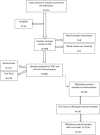The performance of hepatitis C virus (HCV) antibody point-of-care tests on oral fluid or whole blood and dried blood spot testing for HCV serology and viral load among individuals at higher risk for HCV in South Africa
- PMID: 33614978
- PMCID: PMC7876859
- DOI: 10.1002/hsr2.229
The performance of hepatitis C virus (HCV) antibody point-of-care tests on oral fluid or whole blood and dried blood spot testing for HCV serology and viral load among individuals at higher risk for HCV in South Africa
Abstract
Background and aims: To enhance screening and diagnosis in those at-risk of hepatitis C virus (HCV), efficient and improved sampling and testing is required. We investigated the performance of point-of-care (POC) tests and dried blood spots (DBS) for HCV antibody and HCV RNA quantification in individuals at higher risk for HCV (people who use and inject drugs, sex workers and men who have sex with men) in seven South African cities.
Methods: Samples were screened on the OraQuick HCV POC test (471 whole blood and 218 oral fluid); 218 whole blood and DBS paired samples were evaluated on the ARCHITECT HCV antibody (Abbott) and HCV viral load (COBAS Ampliprep/COBAS TaqMan version 2) assays. For HCV RNA quantification, 107 dB were analyzed with and without normalization coefficients.
Results: POC on either whole blood or oral fluid showed an overall sensitivity of 98.5% (95% CI 97.4-99.5), specificity of 98.2% (95% CI 98.8-100) and accuracy of 98.4% (95% CI 96.5-99.3). On the antibody immunoassay, DBS showed a sensitivity of 96.0% (95% CI 93.4-98.6), specificity of 97% (95% CI 94.8-99.3) and accuracy of 96.3% (95% CI 93.8-98.8). A strong correlation (R 2 = 0.90) between viral load measurements for DBS and plasma samples was observed. After normalization, DBS viral load results showed an improved bias from 0.5 to 0.16 log10 IU/mL.
Conclusion: The POC test performed sufficiently well to be used for HCV screening in at-risk populations. DBS for diagnosis and quantification was accurate and should be considered as an alternative sample to test. POC and DBS can help scale up hepatitis services in the country, in light of our elimination goals.
Keywords: HCV; dried blood spot; high risk; point‐of‐care; screening.
© 2021 The Authors. Health Science Reports published by Wiley Periodicals LLC.
Conflict of interest statement
Andrew Scheibe received an honourarium from Gilead for presenting work in this field.
Figures



Similar articles
-
Impact of storage time in dried blood samples (DBS) and dried plasma samples (DPS) for point-of-care hepatitis C virus (HCV) RNA quantification and HCV core antigen detection.Microbiol Spectr. 2023 Sep 1;11(5):e0174823. doi: 10.1128/spectrum.01748-23. Online ahead of print. Microbiol Spectr. 2023. PMID: 37655908 Free PMC article.
-
Clinical utility of HCV core antigen detection and quantification using serum samples and dried blood spots in people who inject drugs in Dar-es-Salaam, Tanzania.J Int AIDS Soc. 2017 Sep 19;20(1):21856. doi: 10.7448/IAS.20.1.21856. J Int AIDS Soc. 2017. PMID: 28953324 Free PMC article.
-
Evaluation of the performance of Abbott m2000 and Roche COBAS Ampliprep/COBAS Taqman assays for HIV-1 viral load determination using dried blood spots and dried plasma spots in Kenya.PLoS One. 2017 Jun 16;12(6):e0179316. doi: 10.1371/journal.pone.0179316. eCollection 2017. PLoS One. 2017. PMID: 28622370 Free PMC article.
-
Diagnostic Accuracy of Assays Using Point-of-Care Testing or Dried Blood Spot Samples for the Determination of Hepatitis C Virus RNA: A Systematic Review.J Infect Dis. 2022 Sep 21;226(6):1005-1021. doi: 10.1093/infdis/jiac049. J Infect Dis. 2022. PMID: 35150578
-
Impact of hepatitis C virus point-of-care RNA viral load testing compared with laboratory-based testing on uptake of RNA testing and treatment, and turnaround times: a systematic review and meta-analysis.Lancet Gastroenterol Hepatol. 2023 Mar;8(3):253-270. doi: 10.1016/S2468-1253(22)00346-6. Epub 2023 Jan 24. Lancet Gastroenterol Hepatol. 2023. PMID: 36706775 Free PMC article.
Cited by
-
RT-LAMP-Based Molecular Diagnostic Set-Up for Rapid Hepatitis C Virus Testing.Biosensors (Basel). 2022 May 5;12(5):298. doi: 10.3390/bios12050298. Biosensors (Basel). 2022. PMID: 35624599 Free PMC article.
-
Analysis of Inflammatory and Thyroid Hormone Levels Based on Hepatitis A and B Virus Immunity Status: Age and Sex Stratification.Viruses. 2024 Aug 20;16(8):1329. doi: 10.3390/v16081329. Viruses. 2024. PMID: 39205303 Free PMC article.
-
Quality Assurance for Hepatitis C Virus Point-of-Care Diagnostics in Sub-Saharan Africa.Diagnostics (Basel). 2023 Feb 12;13(4):684. doi: 10.3390/diagnostics13040684. Diagnostics (Basel). 2023. PMID: 36832172 Free PMC article. Review.
-
A simplified point-of-service model for hepatitis C in people who inject drugs in South Africa.Harm Reduct J. 2023 Mar 4;20(1):27. doi: 10.1186/s12954-023-00759-0. Harm Reduct J. 2023. PMID: 36870990 Free PMC article.
-
Balancing Efficiency and Accuracy in Hepatitis C Rapid Antibody Testing: Insights From a Cluster Randomised Crossover Trial.J Viral Hepat. 2025 Aug;32(8):e70043. doi: 10.1111/jvh.70043. J Viral Hepat. 2025. PMID: 40607684 Free PMC article. Clinical Trial.
References
-
- World Health Organization . Global hepatitis report 2017. https://www.who.int/hepatitis/publications/global-hepatitis-report2017/en/. Accessed December 17, 2019.
-
- Alter MJ. The detection, transmission, and outcome of hepatitis C virus infection. Infect Agents Dis. 1993;2(3):155‐166. - PubMed
-
- World Health Organization . Guidelines for the care and treatment of persons diagnosed with chronic hepatitis C virus infection 2018. https://www.who.int/hepatitis/publications/hepatitis-c-guidelines-2018/en/. Accessed June 1, 2020. - PubMed
-
- Madhava V, Burgess C, Drucker E. Epidemiology of chronic hepatitis C virus infection in sub‐Saharan Africa. Lancet Infect Dis. 2002;2(5):293‐302. - PubMed
LinkOut - more resources
Full Text Sources
Other Literature Sources
Miscellaneous

